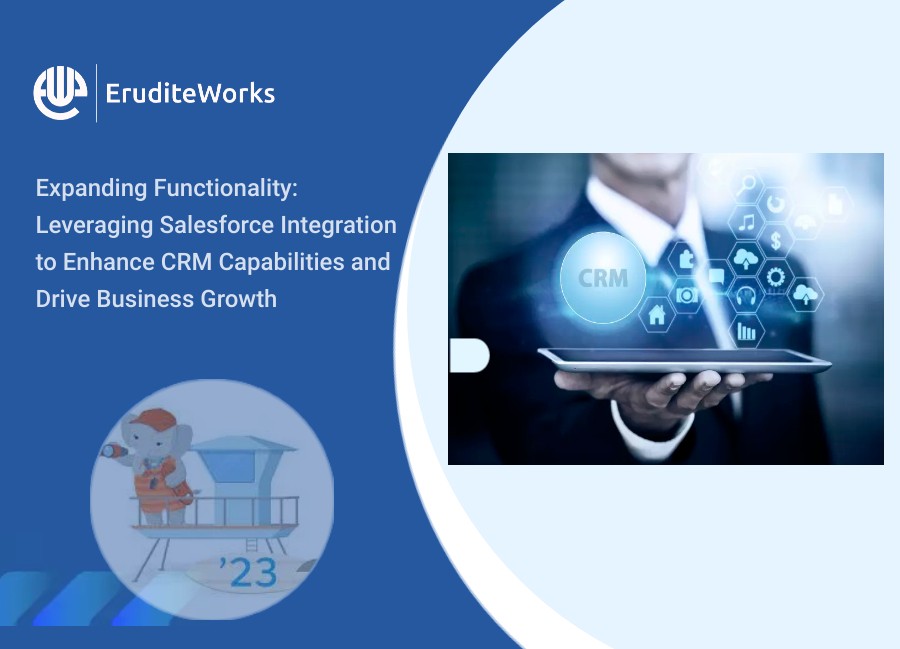Customer Relationship Management (CRM) is crucial for growth in the ever-evolving business landscape. It enables companies to build and nurture valuable relationships with their customers.
It centralizes customer data and provides insights for personalized marketing, improved service, and sales strategies, which enhances customer satisfaction and loyalty.
Businesses can identify growth opportunities, anticipate customer needs, and adapt to market trends effectively.
CRM empowers companies to maximize revenue, reduce costs, and remain competitive.
Salesforce is one of the top-tier CRM platforms. So, CRM and Salesforce Integration go hand in hand.
The integration of Salesforce with CRM systems or other software applications is a strategic approach that combines the capabilities of both, often with the expertise of Salesforce integration partners. This collaboration enhances business processes and customer relationship management, ensuring seamless integration and successful implementation.
Let’s have a better understanding of Salesforce Integration.
Integration can involve data synchronization, application connectivity, or workflow automation, depending on business needs.
By integrating Salesforce, organizations can centralize customer information, automate workflows, and improve efficiency. Let us also tell you about its benefits.
Benefits of Salesforce integration
Salesforce integration offers a multitude of benefits for businesses. Here are some key benefits:
- It streamlines operations by centralizing data and automating processes, enhancing efficiency, which leads to improved customer services, as support teams access a comprehensive customer view.
- Integration facilitates data accuracy by eliminating manual data entry errors and ensures real-time updates across systems, aiding in better decision-making.
- Salesforce integration provides a 360-degree view of customers, enabling personalized marketing and better customer service.
- It optimizes sales, marketing, and customer support workflows.
It streamlines operations by centralizing data and automating processes, enhancing efficiency, which leads to improved customer services, as support teams access a comprehensive customer view.
Salesforce integration empowers organizations to boost productivity, cut costs, and drive growth.
Different Salesforce integration techniques exist to achieve effective Salesforce integration and bridge the gap between Salesforce and external systems.
Let’s have a brief understanding of it.
Key Salesforce Integration Techniques
API Integration:
Salesforce offers robust REST and SOAP APIs that allows seamless data exchange between Salesforce and other applications. It is a versatile and widely used integration method.
Custom Development:
Organizations can build custom integrations using programming languages like Apex (for Salesforce) or languages like Java, Python, or .NET for external systems. This approach offers maximum flexibility.
Third-party App Integration:
Consider using third-party integration tools like Zapier or Integromat for simple, non-technical integrations.
Still wondering how leveraging Salesforce integration can benefit your business and drive business by enhancing CRM capabilities? Well, we have got you covered! Keep reading!
Enhancing CRM Capabilities with Salesforce Integration
Salesforce is known for its robust features, and when effectively integrated, it can significantly improve your CRM functions:
Data Centralization:
Salesforce acts as a central repository for customer data, ensuring that sales, marketing, and support teams have access to the most up-to-date and consistent information. This centralization eliminates data silos and enhances collaboration.
Automation:
Salesforce offers tools like Process Builder and Workflow Rules, which can automate routine tasks, lead routing, and follow-up, increasing efficiency and reducing manual workloads.
Seamless Integration:
Salesforce can be integrated with other systems and applications, including marketing automation tools, e-commerce platforms, and external databases. The integration enables real-time exchange of data. It ensures that all teams have access to the most up-to-date information.
Customization:
Salesforce is highly customizable. It allows you to tailor the platform to your unique business needs. You can create custom fields, objects, and processes to align with your CRM strategy.
Improved Efficiency:
Salesforce’s automation and workflow capabilities optimize various business processes, from lead management to customer support. Teams can work more efficiently and collaborate effectively, resulting in improved productivity.
Reporting and Analytics:
Salesforce provides robust reporting and analytics capabilities, enabling data-driven decision-making. You can also keep track of KPIs (key performance indicators) and gain insights into customer behavior.
Customer Support:
Salesforce Service Cloud extends CRM capabilities to customer support, enabling efficient case management, knowledge sharing, and customer self-service options.
By enhancing CRM capabilities with Salesforce, businesses can experience several key benefits:
Unified Customer Data:
A single source of customer data ensures that every department has consistent, accurate information.
Streamlined Processes:
Automation and integration reduce manual tasks and data duplication, resulting in more efficient operations.
Better Customer Insights:
A 360-degree customer view and analytics provide valuable insights that inform more targeted marketing and sales efforts.
Data-Driven Growth:
Informed decision-making based on data leads to more effective customer acquisition, retention, and expansion strategies.
Conclusion
Salesforce integration has an essential role in shaping the future of customer relationship management and, by extension, the success of businesses. It’s not just about enhancing CRM capabilities; it’s about driving business growth, forging lasting connections with customers, and thriving in a dynamic and ever-changing market.
We hope you enjoyed the read! It’s a wrap!
Also Read: Common challenges faced during Salesforce implementation and how a partner can help overcome them







0 Comments